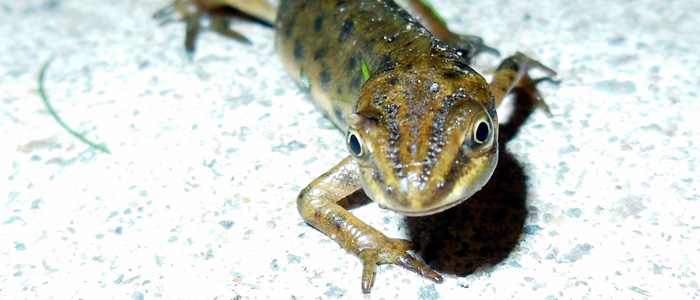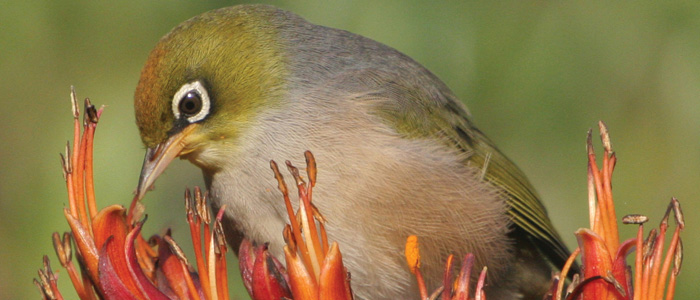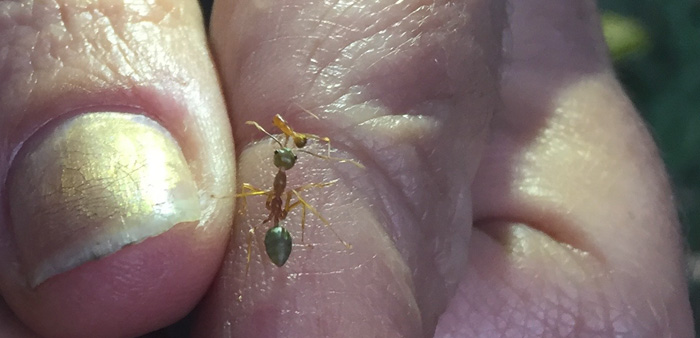
Wilderness adventurers clean out Tasmania’s sea spurge threat
They call themselves Sea Spurge Remote Area Teams – SPRATS for short – and since 2007 they’ve been at the cutting-edge of ‘adventure conservation’.

They call themselves Sea Spurge Remote Area Teams – SPRATS for short – and since 2007 they’ve been at the cutting-edge of ‘adventure conservation’.

A new resident has taken up residence in Melbourne’s suburbs, one that could bring with it an entirely new amphibian order.

A new resident has taken up residence in Melbourne’s suburbs, one that could bring with it an entirely new amphibian order.

There is a silent invasion taking place in Australia that could fundamentally alter our way of life.

What would it be like living in an Australia overrun by infestations of red fire ants? Find out why these menacing ants represent such a huge threat at one of our upcoming fire ant forums.

What would it be like living in an Australia overrun by infestations of red fire ants? Find out why these menacing ants represent such a huge threat at one of our upcoming fire ant forums.

The creation of a new national body geared towards preparing Australia for future environmental invasions is just one idea thrown up at the first ever environmental biosecurity forum.

The way feral animals and weeds are being managed in NSW is set for an overhaul and there’s a chance for you to help make sure the environment isn’t forgotten.

A program to rid Australia of yellow crazy ants has been bought back to life with the injection of $10.5 million over the next three years, but is it enough to secure Queensland’s Wet Tropics World Heritage Area from this dangerous invasive species?

A program to rid Australia of yellow crazy ants has been bought back to life with the injection of $10.5 million over the next three years, but is it enough to secure Queensland’s Wet Tropics World Heritage Area from this dangerous invasive species?

Australia’s Ashmore Reef is a sanctuary for migratory seabirds and green sea turtles, but a deadly predator has made it onto the island and is putting native wildlife at risk.

In Hawaii it has smothered everything in its path, but in Australia we still have time to stop Koster’s curse, an invasive weed that has been labelled Australia’s next lantana.

In Hawaii it has smothered everything in its path, but in Australia we still have time to stop Koster’s curse, an invasive weed that has been labelled Australia’s next lantana.

While in Cairns recently we saw evidence that local efforts are winning the war on yellow crazy ants, but community efforts still need all the help they can get if they are to turn the tide on this highly invasive ant.

Has the Australian Government given up on tackling weeds and feral animals? New draft strategies contain no actions and no new initiatives. They are devoid of substance.

They call themselves Sea Spurge Remote Area Teams – SPRATS for short – and since 2007 they’ve been at the cutting-edge of ‘adventure conservation’.

A new resident has taken up residence in Melbourne’s suburbs, one that could bring with it an entirely new amphibian order.

A new resident has taken up residence in Melbourne’s suburbs, one that could bring with it an entirely new amphibian order.

There is a silent invasion taking place in Australia that could fundamentally alter our way of life.

What would it be like living in an Australia overrun by infestations of red fire ants? Find out why these menacing ants represent such a huge threat at one of our upcoming fire ant forums.

What would it be like living in an Australia overrun by infestations of red fire ants? Find out why these menacing ants represent such a huge threat at one of our upcoming fire ant forums.

The creation of a new national body geared towards preparing Australia for future environmental invasions is just one idea thrown up at the first ever environmental biosecurity forum.

The way feral animals and weeds are being managed in NSW is set for an overhaul and there’s a chance for you to help make sure the environment isn’t forgotten.

A program to rid Australia of yellow crazy ants has been bought back to life with the injection of $10.5 million over the next three years, but is it enough to secure Queensland’s Wet Tropics World Heritage Area from this dangerous invasive species?

A program to rid Australia of yellow crazy ants has been bought back to life with the injection of $10.5 million over the next three years, but is it enough to secure Queensland’s Wet Tropics World Heritage Area from this dangerous invasive species?

Australia’s Ashmore Reef is a sanctuary for migratory seabirds and green sea turtles, but a deadly predator has made it onto the island and is putting native wildlife at risk.

In Hawaii it has smothered everything in its path, but in Australia we still have time to stop Koster’s curse, an invasive weed that has been labelled Australia’s next lantana.

In Hawaii it has smothered everything in its path, but in Australia we still have time to stop Koster’s curse, an invasive weed that has been labelled Australia’s next lantana.

While in Cairns recently we saw evidence that local efforts are winning the war on yellow crazy ants, but community efforts still need all the help they can get if they are to turn the tide on this highly invasive ant.

Has the Australian Government given up on tackling weeds and feral animals? New draft strategies contain no actions and no new initiatives. They are devoid of substance.

They call themselves Sea Spurge Remote Area Teams – SPRATS for short – and since 2007 they’ve been at the cutting-edge of ‘adventure conservation’.

A new resident has taken up residence in Melbourne’s suburbs, one that could bring with it an entirely new amphibian order.

A new resident has taken up residence in Melbourne’s suburbs, one that could bring with it an entirely new amphibian order.

There is a silent invasion taking place in Australia that could fundamentally alter our way of life.

What would it be like living in an Australia overrun by infestations of red fire ants? Find out why these menacing ants represent such a huge threat at one of our upcoming fire ant forums.

What would it be like living in an Australia overrun by infestations of red fire ants? Find out why these menacing ants represent such a huge threat at one of our upcoming fire ant forums.

The creation of a new national body geared towards preparing Australia for future environmental invasions is just one idea thrown up at the first ever environmental biosecurity forum.

The way feral animals and weeds are being managed in NSW is set for an overhaul and there’s a chance for you to help make sure the environment isn’t forgotten.

A program to rid Australia of yellow crazy ants has been bought back to life with the injection of $10.5 million over the next three years, but is it enough to secure Queensland’s Wet Tropics World Heritage Area from this dangerous invasive species?

A program to rid Australia of yellow crazy ants has been bought back to life with the injection of $10.5 million over the next three years, but is it enough to secure Queensland’s Wet Tropics World Heritage Area from this dangerous invasive species?

Australia’s Ashmore Reef is a sanctuary for migratory seabirds and green sea turtles, but a deadly predator has made it onto the island and is putting native wildlife at risk.

In Hawaii it has smothered everything in its path, but in Australia we still have time to stop Koster’s curse, an invasive weed that has been labelled Australia’s next lantana.

In Hawaii it has smothered everything in its path, but in Australia we still have time to stop Koster’s curse, an invasive weed that has been labelled Australia’s next lantana.

While in Cairns recently we saw evidence that local efforts are winning the war on yellow crazy ants, but community efforts still need all the help they can get if they are to turn the tide on this highly invasive ant.

Has the Australian Government given up on tackling weeds and feral animals? New draft strategies contain no actions and no new initiatives. They are devoid of substance.
Get our blog the Feral Herald delivered to your inbox.

The Invasive Species Council was formed in 2002 to seek stronger laws, policies and programs to protect nature from harmful pests, weeds and diseases.
The Invasive Species Council acknowledges the Traditional Custodians throughout Australia and their connections to land and sea. We pay our respect to their Elders past and present and extend that respect to all Aboriginal and Torres Strait Islander peoples today.
Our protected areas are being trashed, trampled, choked and polluted by an onslaught of invaders. Invasive species are already the overwhelming driver of our animal extinction rate, and are expected to cause 75 of the next 100 extinctions.
But you can help to turn this around and create a wildlife revival in Australia.
From numbats to night parrots, a tax-deductible donation today can help defend our wildlife against the threat of invasive weeds, predators, and diseases.
As the only national advocacy environment group dedicated to stopping this mega threat, your gift will make a big difference.
A silent crisis is unfolding across Australia. Every year, billions of native animals are hunted and killed by cats and foxes. Fire ants continue to spread and threaten human health. And the deadly strain of bird flu looms on the horizon. Your donation today will be used to put the invasive species threat in the media, make invasive species a government priority, ensure governments take rapid action to protect nature and our remarkable native wildlife from invasives-led extinction, death and destruction.
If you are having trouble submitting a form, please read this guide.
Please fill out the following form and one of our team will be in contact to assist as soon as possible. Please make sure to include any helpful information, such as the device you were using (computer, tablet or mobile phone) and if known, your browser (Mozilla Firefox, Chrome, Safari etc)
"*" indicates required fields
Dear Project Team,
[YOUR PERSONALISED MESSAGE WILL APPEAR HERE.]
I support the amendment to the Kosciuszko National Park Wild Horse Heritage Management Plan to allow our incredible National Parks staff to use aerial shooting as one method to rapidly reduce feral horse numbers. I want to see feral horse numbers urgently reduced in order to save the national park and our native wildlife that live there.
The current approach is not solving the problem. Feral horse numbers have rapidly increased in Kosciuszko National Park to around 18,000, a 30% jump in just the past 2 years. With the population so high, thousands of feral horses need to be removed annually to reduce numbers and stop our National Park becoming a horse paddock. Aerial shooting, undertaken humanely and safely by professionals using standard protocols, is the only way this can happen.
The government’s own management plan for feral horses states that ‘if undertaken in accordance with best practice, aerial shooting can have the lowest negative animal welfare impacts of all lethal control methods’.
This humane and effective practice is already used across Australia to manage hundreds of thousands of feral animals like horses, deer, pigs, and goats.
Trapping and rehoming of feral horses has been used in Kosciuszko National Park for well over a decade but has consistently failed to reduce the population, has delayed meaningful action and is expensive. There are too many feral horses in the Alps and not enough demand for rehoming for it to be relied upon for the reduction of the population.
Fertility control as a management tool is only effective for a small, geographically isolated, and accessible population of feral horses where the management outcome sought is to maintain the population at its current size. It is not a viable option to reduce the large and growing feral horse population in the vast and rugged terrain of Kosciuszko National Park.
Feral horses are trashing and trampling our sensitive alpine ecosystems and streams, causing the decline and extinction of native animals. The federal government’s Threatened Species Scientific Committee has stated that feral horses ‘may be the crucial factor that causes final extinction’ for 12 alpine species.
I recognise the sad reality that urgent and humane measures are necessary to urgently remove the horses or they will destroy the Snowies and the native wildlife that call the mountains home. I support a healthy national park where native species like the Corroboree Frog and Mountain Pygmy Possum can thrive.
Dear Project Team,
[YOUR PERSONALISED MESSAGE WILL APPEAR HERE.]
I support the amendment to the Kosciuszko National Park Wild Horse Heritage Management Plan to allow our incredible National Parks staff to use aerial shooting as one method to rapidly reduce feral horse numbers. I want to see feral horse numbers urgently reduced in order to save the national park and our native wildlife that live there.
The current approach is not solving the problem. Feral horse numbers have rapidly increased in Kosciuszko National Park to around 18,000, a 30% jump in just the past 2 years. With the population so high, thousands of feral horses need to be removed annually to reduce numbers and stop our National Park becoming a horse paddock. Aerial shooting, undertaken humanely and safely by professionals using standard protocols, is the only way this can happen.
The government’s own management plan for feral horses states that ‘if undertaken in accordance with best practice, aerial shooting can have the lowest negative animal welfare impacts of all lethal control methods’.
This humane and effective practice is already used across Australia to manage hundreds of thousands of feral animals like horses, deer, pigs, and goats.
Trapping and rehoming of feral horses has been used in Kosciuszko National Park for well over a decade but has consistently failed to reduce the population, has delayed meaningful action and is expensive. There are too many feral horses in the Alps and not enough demand for rehoming for it to be relied upon for the reduction of the population.
Fertility control as a management tool is only effective for a small, geographically isolated, and accessible population of feral horses where the management outcome sought is to maintain the population at its current size. It is not a viable option to reduce the large and growing feral horse population in the vast and rugged terrain of Kosciuszko National Park.
Feral horses are trashing and trampling our sensitive alpine ecosystems and streams, causing the decline and extinction of native animals. The federal government’s Threatened Species Scientific Committee has stated that feral horses ‘may be the crucial factor that causes final extinction’ for 12 alpine species.
I recognise the sad reality that urgent and humane measures are necessary to urgently remove the horses or they will destroy the Snowies and the native wildlife that call the mountains home. I support a healthy national park where native species like the Corroboree Frog and Mountain Pygmy Possum can thrive.